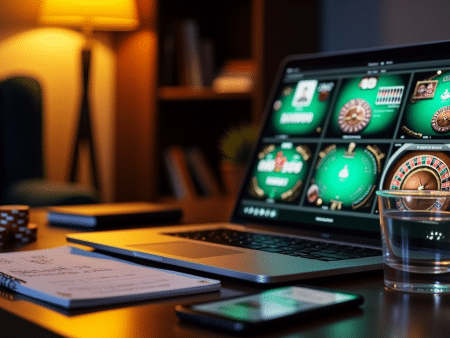 Professional poker players bluff only about 25% of the time. Most amateur players wrongly assume the pros bluff during nearly half their hands.
Professional poker players bluff only about 25% of the time. Most amateur players wrongly assume the pros bluff during nearly half their hands.
My years of studying and using different poker strategies taught me something valuable. Bluffing isn’t about deception – it tells a convincing story through betting patterns and timing.
Players often lose money on failed bluffs or feel too scared to bluff. However, becoming skilled at this poker technique doesn’t require gambling. Successful bluffing relies on specific techniques and perfect timing.
The proven poker bluffing strategies that work include reading opponent behaviors and executing well-timed bluffs. Your bluffing approach can shift from guesswork to a calculated, winning strategy.
Understanding Poker Bluffing Psychology
The psychology of bluffing runs deeper than most players realize. My years at the poker tables have taught me that successful bluffing comes down to understanding human behavior and decision-making patterns.
The Science Behind Successful Bluffs
Bluffing in poker is psychological warfare at its core. Research shows that successful bluffs win about 12% of all hands, even without the best cards. My experience shows that bluffing isn’t just deception – you need to build a convincing story through your actions.
These three core psychological principles have worked best for me:
- Timing manipulation: Quick decisions often signal strength, while delayed actions typically indicate weakness
- Risk perception: Players hesitate more to lose what they have than to gain something new
- Fear exploitation: You can use your opponent’s uncertainty to your advantage
Reading Opponent Behavior Patterns
Reading opponents goes way beyond spotting classic “tells.” Timing tells can reveal the most important information about hand strength. These patterns have proven most reliable in my experience:
- Instant checks almost always indicate weakness
- Betting after long delays typically shows genuine strength
- Quick calls usually suggest medium-strength hands or drawing hands
Managing Your Own Psychological State
You need psychological control for your bluffs to work. My focus stays on three key aspects of mental game management:
I accept uncertainty instead of fearing it. This mindset keeps me calm when pressure builds. Positive self-talk helps boost my confidence in decisions.
Discipline shapes psychological control significantly. I follow my predetermined strategies rather than making emotional decisions. Patience becomes vital – I wait for the right bluffing spots instead of forcing plays.
Emotional control directly affects how well you decide. Players make more rational choices based on logic when they stay composed. The game flow helps you avoid overbluffing – a mistake that makes players easy to read.
Note that your bluffing patterns should match the table image you’re building. This needs constant awareness of how others see your playing style so you can adjust your game.
Essential Bluffing Fundamentals
Let’s head over to the technical aspects of bluffing that make the difference between amateur players and professionals. Learning these fundamentals is vital to achieve consistent success at the poker table.
Choosing the Right Spots to Bluff
The most important factor in successful bluffing is picking the right opponent. Players who can actually fold their hands make the best targets – good players are easier to bluff than bad ones. There’s another reason that makes players great bluff targets – those who just won a large pot or sit close to even tend to focus more on keeping their stack safe.
Calculating Bluff Success Probability
The mathematics behind bluffing revolutionized my game. Here’s a proven formula I use to calculate bluff probability:
- Risk divided by (Risk + Reward) equals breakeven percentage
- A half-pot sized bet needs to work 33% of the time to break even
- A pot-sized bet must succeed 50% of the time to be profitable
- A double pot-sized bet requires 67% success rate
My bluffs are arranged to match these mathematical principles. To cite an instance, a small bet of 25% pot size only needs a 20% success rate to profit.
Position-Based Bluffing Strategy
Position plays a huge role in bluffing success. These position-based principles guide my game:
- Late positions (hijack, cutoff, button) give you the best bluffing opportunities
- Early position bluffs are by a lot riskier because many players have yet to act
- Position lets you see how opponents react before you decide to bluff
Bluffing becomes more effective as the game moves forward, especially in tournament settings. Still, I stay away from bluffing against multiple players since the chances of someone holding a strong hand increase by a lot.
Bet sizing in position is everything I’ve become skilled at. To cite an instance, my late position bluffs tell a consistent story – if my previous betting didn’t show a flush draw, I won’t suddenly pretend to have one on the river.
Note that your opponents determine if a bluff will work. That’s why table dynamics need careful thought before any bluff. The right position, opponent, and bet size create a powerful mix that’s nowhere near easy to defend against.
Building Your Bluffing Arsenal
My poker game has changed from predictable to formidable by building a variety of bluffing moves. I found that there was more than one way to win, even without premium hands, once I became skilled at different bluffing techniques.
Semi-Bluff Techniques
Semi-bluffing has become my go-to strategy because it gives me two shots at winning. My original lesson showed that semi-bluffs are profitable when they work just one-third of the time. Here’s how I plan my semi-bluffs:
- Calculate pot commitment (multiply big blind by at least 10)
- Assess fold equity against opponent’s range
- Think over backdoor possibilities
- Review position advantage
Of course, flush draws and open-ended straight draws make great semi-bluff candidates. I make sure my bet sizing grows steadily to keep the pressure on and avoid showing weakness.
Pure Bluff Execution
Pure bluffs work best with perfect timing and reading your opponent well. The challenge is real, but I’ve learned to spot the best pure bluffing opportunities:
- Late position when players to my left show tight tendencies
- Post-flop in last position with innocuous boards
- On low paired boards when checked to
- During tournament bubble situations against short stacks
Pure bluffs work better against solid players who can fold hands, unlike calling stations who hang onto their cards.
Multi-Street Bluffing Patterns
Multi-street bluffing needs careful planning and board reading skills. I look at three key factors before trying a triple-barrel bluff:
- Board texture and its interaction with my perceived range
- Opponent’s folding tendencies on each street
- My previous betting patterns
When I run multi-street bluffs, I prefer hands with extra equity like backdoor flush draws or gutshot straight draws. I’ve learned to adjust my aggression based on how my opponents respond – if they’re just calling, I often turn up the heat on the turn.
A vital skill I’ve picked up is knowing when to give up on a bluff. I know it’s time to cut my losses when my opponent matches my aggression. Successful multi-street bluffing ended up needing both board texture knowledge and opponent reading skills to tell a convincing story through betting patterns.
Mastering Live Poker Tells
My years at live poker tables have taught me that becoming skilled at reading tells requires both careful watching and understanding what you see. The goal is to build a complete picture of how your opponents behave.
Physical Tell Recognition
Experience shows that reliable physical tells usually come in groups. These combinations have proven most dependable at the tables:
- Trembling hands with regular breathing indicates genuine strength
- Defensive chip movements before checking suggest weakness
- Players who reach for chips right after facing a bet show vulnerability
- Players double-checking hole cards after betting signals relaxation and strength
Casual players display these tells more consistently than pros. Rather than looking for isolated behaviors, I watch for patterns that emerge together.
Timing Tells Analysis
Time-based tells rank among the most reliable indicators at the poker table. My notes reveal these consistent patterns:
| Action | Interpretation | Reliability |
|---|---|---|
| Instant calls | Usually indicates medium-strength hands | Very High |
| Long pauses followed by raises | Often signals genuine strength | High |
| Quick reactions | Typically caps range at one pair or draws | Medium |
Betting Pattern Interpretation
Betting patterns give us the most practical information in live poker. Players who keep their bet sizing consistent on the flop and turn often signal weakness. The most reliable read comes from watching how opponents handle different board textures.
A vital pattern emerges in bet sizing variations. Players making small bets with strong hands usually want value. Those who make theatrical movements while betting tend to hold weaker hands.
I watch closely when players break from their usual betting patterns. To cite an instance, see how a typically aggressive player making minimum bets often shows uncertainty. The same applies to players who suddenly increase their bet sizing – this reveals either massive strength or complete bluffs.
Reading these patterns starts with knowing each opponent’s baseline. The first 30 minutes at any table go into watching how players bet in normal situations. This early investment helps me spot meaningful changes in their patterns throughout my session.
Online Bluffing Strategies
Online poker offers unique bluffing opportunities that are quite different from live games. I’ve become skilled at these digital dynamics by playing thousands of hands on poker platforms of all sizes.
Timing Tells in Online Play
Timing tells work surprisingly well in virtual environments. Quick decisions often show pre-planned actions, which point to either real strength or complete air. Let me share how I read common timing patterns:
- Instant checks show weakness or capped ranges
- 30-40 second delays before raises usually mean strength
- Quick actions across streets point to automated play
My first priority is to establish baseline timing for each opponent. This takes careful observation during the first few orbits.
Using HUD Stats Effectively
HUD statistics have transformed my online bluffing strategy. A good VPIP (Voluntarily Put Money in Pot) sits between 20-30% in 6-handed games. Here’s my framework to read key HUD metrics:
| Statistic | Normal Range | Exploitation Strategy |
|---|---|---|
| VPIP | 20-30% | Target higher numbers |
| PFR | 15-25% | Bluff tight openers |
| 3-Bet | 6-10% | Exploit passive players |
Without doubt, these stats need good sample sizes. I wait for at least 300 hands before making big adjustments. Players who show extreme statistics become prime targets for strategic bluffs.
Digital Behavior Analysis
My extensive online play has revealed reliable patterns in digital behavior. Regular players show different timing when they’re focused on a hand versus when they’re multi-tabling.
I watch closely for:
- Auto-action button usage patterns
- Bet sizing consistency
- Response times to board texture changes
- Multi-street betting sequences
To cite an instance, regular players who take longer than usual are likely reviewing their HUD data or thinking about a light three-bet. This knowledge helps me adjust my strategy.
Reading opponents who use intimidation tactics through bet sizing is vital. When they use multiple smaller denomination chips instead of one large chip, they often try to appear stronger.
Pro players adjust their game based on HUD statistics. I keep my timing consistent to avoid giving away information. I also use software like TimeMojo to randomize my timing, which makes my patterns harder to spot.
Research shows online poker has 44.5 million regular players. This big player pool makes understanding digital tells more important than ever. Success in online bluffing comes from mixing technical analysis with psychological insight.
Advanced Bluff Defense
Becoming skilled at bluff defense plays a vital role in today’s aggressive poker world. I found that defending against bluffs needs a delicate balance of mathematics, psychology, and careful observation.
Spotting Opponent Bluff Patterns
My extensive analysis shows that players bluff less often than most people think. My approach to spotting bluffs focuses on these key areas:
- Board texture analysis and missed draws
- Betting patterns across multiple streets
- Timing inconsistencies in decision-making
- Physical tells in live games
Players who are on tilt tend to bluff more often. When I face unknown opponents, I stick to mathematical principles instead of behavioral reads.
Counter-Bluffing Techniques
The best counter-bluffing strategy isn’t always about making calls. My experience led me to develop three main counter-strategies:
- Re-raising with strong drawing hands
- Floating with position advantage
- Using blocking bets to prevent large bluffs
These techniques need adjustments based on opponent types. My counter-bluffs tell a consistent story across all streets when timed right.
Optimal Defense Frequencies
My framework for defense frequencies looks like this:
| Bet Size | Minimum Defense Required | Optimal Calling Range |
|---|---|---|
| 1/2 Pot | 33% of hands | Top pairs and strong draws |
| Full Pot | 50% of hands | Premium hands and draws |
| 2x Pot | 67% of hands | Very strong hands only |
Minimum Defense Frequency (MDF) shows how often we need to call or raise to make opponent’s bluffs unprofitable. You shouldn’t apply this concept blindly. Players who rarely bluff make me adjust my defense frequency much lower.
I learned to spot situations where MDF doesn’t work:
- Against opponents who can’t bluff effectively
- When facing players with unbalanced ranges
- During tournament bubble situations
- In multiway pots
My defense frequency calculations use this formula: MDF = Pot Size / (Pot Size + Bet Size). This helps me make math-based decisions rather than emotional ones.
Solvers might suggest calling with certain hands 54% of the time, but I simplified this approach for real-life use. I maintain consistent actions with specific hand ranges instead of mixing frequencies with individual hands.
My bluff defense considers three main factors:
- Opponent’s overall aggression frequency
- Board texture and possible missed draws
- My perceived range from villain’s viewpoint
I spot bluffs most accurately when betting patterns don’t match the board texture. Bet sizing tells grab my attention – unusually large bets often signal either extreme strength or complete weakness.
ICM considerations affect optimal defense frequencies in tournaments. Stack sizes and pay jump considerations shape my calling ranges more than pure math in these situations.
Counter-bluffing against suspected light three-bets works well against aggressive regulars who bluff too much on certain board textures. My counter-bluffs stay credible within the context of previous action.
Conclusion
Poker bluffing requires more than courage – players must understand psychology, mathematics, and observe carefully. My experience shows that successful bluffing combines precise timing with strategic thinking.
These principles are the foundations of effective bluffing: select your bluffs against opponents who fold, use position advantage wisely, and maintain betting patterns that tell believable stories. Professional players bluff nowhere near as often as amateurs think.
My trip in poker has shown that defending against bluffs is equally important as executing them. Players should follow optimal defense frequencies, look for reliable tells both live and online, and let mathematics guide them instead of emotions during tough decisions.
These proven techniques should be implemented step by step. Results take time, but patience and practice will turn your bluffing from guesswork into a calculated strategy that builds your stack consistently.



